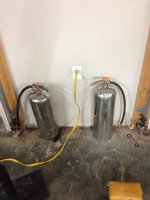Halon doesn't displace oxygen like CO2, but it does have a property where it will produce some phosgene gas when it comes in contact with heated material. If I remember correctly, the temperature to start producing phosgene is north of 900 deg f. The phosgene containing plume has a very distinctive odor, so if you are outdoors get out of the plume, and indoors, exit the area until it clears...the fire will not come back indoors anytime soon once Halon is applied, so you don't have to stick around much until the fire department arrives.
Halon is astoundingly effective. When I was a firefighter, we were doing a controlled/training burn on a 2 story frame farmhouse. We trained most of the day by lighting small fires in the house and extinguishing them. Towards the end of the day, it was time to let it burn and drop into its foundation, and I asked everyone if they wanted to risk staying a little longer to see how effective a Halon extinguisher would be on a big fire. They said sure, so we did it.
We started the fire a 3 points on the main floor and let it get rolling. When flash over occurred, there was flame shooting out the top 1/3rd of all of the (tall) windows on the first floor. I approached a central first floor window and applied a sweeping ~8 second shot from a 20# Halon extinguisher into the bottom of the room. The fire went out within about 10 seconds...all of it.
Astounded, we watched as the fire re-established itself fitfully over the next 10 minutes or so. Since I still had 2/3rds of that extinguisher left, I could have kept dosing that fire periodically and kept it suppressed for a long time, perhaps even long enough to let the heat dissipate and totally extinguish it. I did not do so, however, because I had 30 hot sweaty firefighters behind me that were dreaming of that first beer.
That was probably 15 years ago, and I still have that extinguisher, ready to put out another fire.
Nothing comes close to Halon as an extinguishing agent, and that includes it's "replacements". CO2 is good but it has to be very carefully used indoors due to it's oxygen displacement properties, and a CO2 extinguisher ends up being big and heavy if it has usable capacity which makes it problematic to store in vehicles.
